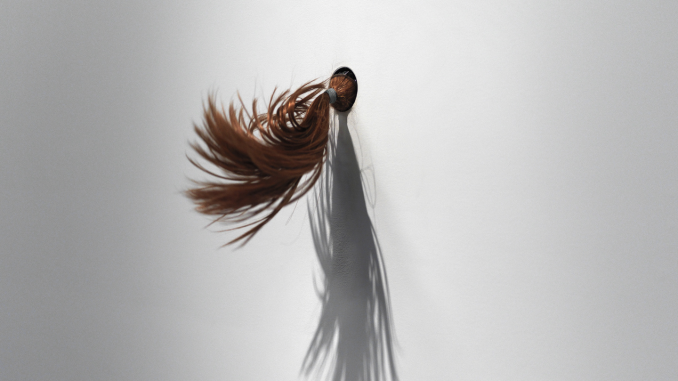
An air conditioner drips water onto a plant; a ponytail jutting out of the wall bops up and down; single drops of water fall from the ceiling and hit a hot skillet, dissipating each drop to vapor; and a single prosthetic-like finger adorned with a galaxy-print acrylic nail slowly rotates from a hole in the wall.
Through two doorways on either side of the gallery space, a number of videos take it all a few steps further: Bunny Glamazon, the six-foot-three dominatrix, rides around a ghost city in China on a moped and sneezes plates of pasta; Chinese women harvest and shuck pearls; Tuvan throat singing rings in the background of ASMR (Autonomous Sensory Meridian Response) sequences of scratching clay and slicing blocks of jelly.
So what’s it all mean? Is every object really just a symbol for the meaning of life and death? More high-falutin’, skill-less, contemporary “art” struggling to find any relevance in our postmodern world? Neo-Marxist propaganda? Are we getting Punk’d?
This is Mika Rottenberg’s Easypieces at the New Museum in the Lower East Side. Since the show is closing this weekend, and since I happen to be writing my thesis on it, I thought I’d do a bit of reflecting on it, and perhaps, make you wish you had seen it if you didn’t.
I wouldn’t mind if Ashton Kutcher came out of the gallery at closing night with a camera crew. That’d for sure be Art. But there is certainly something Easypieces does to its viewers which I don’t normally see so clearly and so viscerally with contemporary art: it makes you react. Whether that reaction is laughter, squirming away disgusted, or getting annoyed (usually, it’s a mix of these, plus more) Rottenberg’s work gets you there.
The objects shown are so banal, yet their meaning, function, and purpose are thrown into question when placed within the walls of the gallery space. The exhibition works to flip our perception of how these things are made and ultimately related on its head. The two standout video works of the show, Spaghetti Blockchain and NoNoseKnows, take all of these concepts that we see sculpturally and heighten them to surrealist extremes.
Rottenberg draws outlandish connections amongst these seemingly alienated occurrences that cause sensations of all kinds in the characters in the films and also in the viewers. Take, for example, the transformation that we see of water into gas on those simple hot skillets in the gallery. In Spaghetti Blockchain, a colorful jelly-cake slowly melts on a griddle; then, in NoNoseKnows, we see beloved Bunny sneezing out plates of fresh noodles while below her a line of people harvest pearls (the former being an allusion of sorts to ASMR videos, which are intended to appeal to the senses of its viewers).
Rottenberg’s obsession with how things are made, connected, and ultimately ephemeral could be taken as a simple Marxist critique of our consumerist globalized world. But a lot of what is going on in Easypieces has more to do with playing with and exposing how strange the world really is, rather than any hard and fast critique of capitalism.
What makes the exhibition so impactful is that each object that the viewer is presented with seems to take on new form and meaning. This means that viewing Easypieces is more than figuring out what the artist means by, say, a two-minute sequence of bubbles floating in empty rooms: this is about exposing and opening up our perception of materials, where they come from, and how they affect us.
Hopefully, Rottenberg gives us another show soon, because I can’t get enough.
